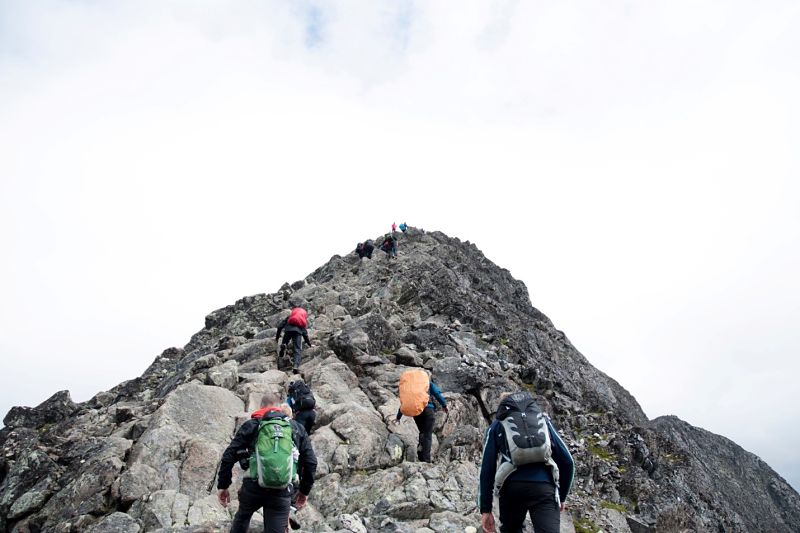Understanding the signs of altitude sickness

Altitude sickness can affect anyone, even experienced climbers. Read on to learn more about acute altitude sickness, and how to manage its symptoms.
Understanding the signs of altitude sickness
Altitude sickness is a surprisingly common problem for all kinds of people - up to 50% of people who reach 2500m above sea level will experience the negative effects of high altitude. It can take just hours for the symptoms to arise, meaning altitude sickness is not just for serious mountain climbers.
Neither your fitness level nor your age make you any less likely to experience the effects of altitude sickness - although younger, fitter climbers may climb faster, and make themselves more vulnerable. If you have experienced altitude sickness in the past, you are more likely to feel the effects of altitude again.
It’s important to understand and recognise the symptoms of acute mountain sickness, so that you can remain safe and well on your next ascent.
What Causes Acute Altitude Sickness?
While many people believe that altitude sickness is simply caused by being at a high altitude, it’s actually a result of ascending too rapidly, without sufficient time to acclimatise to lowered oxygen levels. Acute altitude sickness is the mildest form, and symptoms - which can arise within a few hours of exposure - are occasionally referred to as ‘hangover symptoms’.
To some extent, altitude sickness remains a medical mystery, and the association between lowered oxygen levels and illness is not yet fully understood. The most likely cause is thought to be a build-up of fluid around the brain and lungs.
Luckily, the symptoms are well-documented and, provided you are armed with the proper knowledge, easily spotted.
1. Headache
This is the most obvious sign that you are suffering from altitude sickness. A lack of oxygen reaching your body’s tissues is known medically as hypoxia. If you are making an ascent and begin to experience headaches, experts advise that you should always err on the side of caution, and assume it is altitude sickness.
2. Nausea and Decreased Appetite
Nausea is a common symptom of acute altitude sickness. If you feel unwell, it’s best to lower your altitude in order to acclimatize yourself before symptoms worsen. Vomiting is a more severe sign that your body is struggling to adapt to lack of oxygen.
3. Dizziness and Weakness
This is a strong sign that you have ascended too quickly for your body to cope with. A lack of oxygen in the brain can make you feel dizzy or lightheaded, as though you are about the faint. If so, as with other symptoms, it’s important to take this seriously and move to lower ground before ascending at a slower pace.
4. Difficulty Breathing
Shortness of breath is another tell-tale sign of acute altitude sickness. Fluid in the lungs can make it feel as though you’re unable to take a full breath, and may feel distressing. If you feel you are not breathing properly, do not ascend any higher - if you do, your symptoms can become life threatening.
5. Poor Sleep and Fatigue
There is some debate over whether disturbed sleep patterns are a result of altitude sickness, or other factors. If you are climbing, you may find it difficult to go off to sleep, or feel lethargic when you wake up in the morning. It’s very important that you don’t write-off certain symptoms; if you feel unwell, then it’s essential that you retrace your steps and acclimatise yourself to the environment.
It is recommended that, however high you climb in one day, you ensure that you are sleeping at a lower altitude. This will give your body a chance to adjust gradually to the changes in atmospheric pressure, and prevent your symptoms from progressing overnight.
Managing Acute Altitude Sickness
Before travelling anywhere, it’s always a good idea to make sure you are equipped with a varied supply of travel medications and supplies. You may be travelling to an area where trustworthy and reliable medications are not readily available, which is why it’s always important to plan ahead and bring your own travel medicine pack.
When it comes to high altitude medication, Diamox has been shown as an effective treatment against the symptoms of acute altitude sickness. It works by increasing urine production, reducing the amount of fluid around the brain and in the lungs, and lowering blood pH. It can be used to resolve symptoms while efforts for proper acclimatisation are made.
Diamox can be prescribed and dispensed via Anytime Doctor’s online service, with free next day delivery. If you think your next trip will take you further above sea level than you are used to, then packing a tried and trusted altitude sickness medication will give you the reassurance you need to have a safe and enjoyable journey.
Tags : altitude sickness medication travel medications and supplies free online doctor consultation
